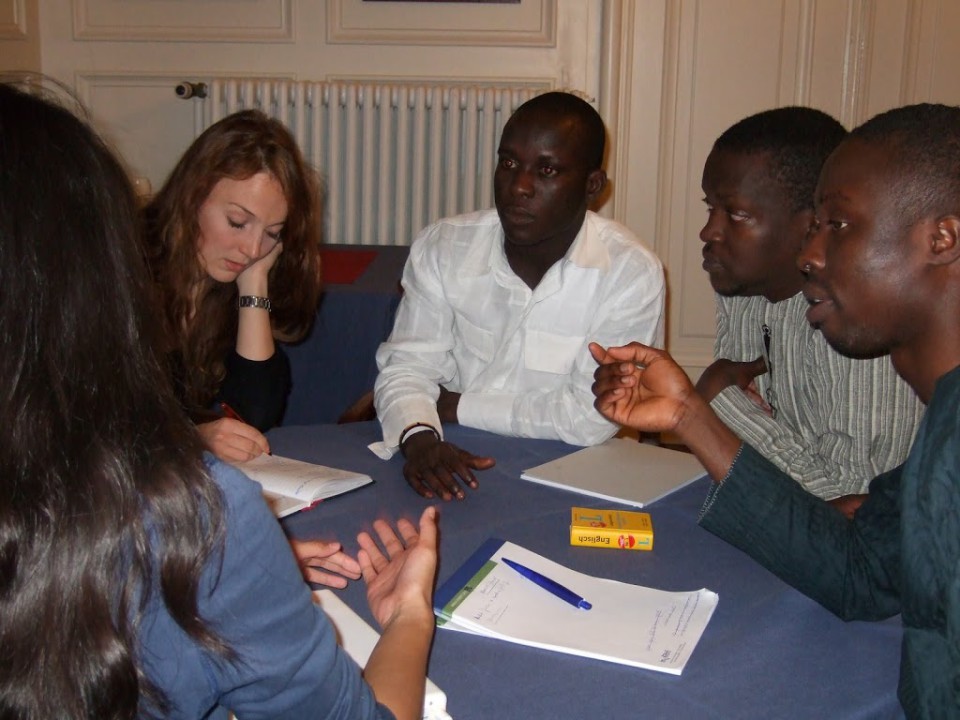Brussels. The ‚waiting lounge’ of the Brussels Port of Transportation looks like a beehive this evening: More than a hundred journalists from all over Europe cling to their pentops and elaborate their coverage about the just finished European Youth Media Days 2057 that have been taken place on the occasion of the 100th jubilee of the Treaty of Rome.
Among the bustling journalists the only person who does not seem to be in a hurry is a woman in the mid-seventies. She sits down hither and thither and takes notes in a notebook that appears anachronistic in this place. The old woman is the media historian C.F. who already witnessed the first European Youth Media Days 50 years ago being a young journalist. In observing she now draws a balance of the development of the media market within the last half century.
In the room’s corner five journalists are sitting on a lounge bench. They know each other of earlier events and constitute one of the many editorial offices ‘on the road’:
Lars used to be part of the Brussels network of correspondents that dissolved when a decade ago a central independent European press agency was created and employed him as many of his colleagues. So instead of being published a day later in the Swedish press, his texts are nowadays translated into the 24 official EU-languages nearly simultaneously. As ‘content-on-demand’-solutions they are being offered to media around the world.
That’s how his commentary about the closing speech by the EU president can be read in the news ticker above the EYMD-report written by Mei-Wu few minutes later. The Asian journalists sitting next to him discovered the Internet as most adequate media to engage in political opinion formation as a political exile. She has founded a journal of political resistance that is read a million times in her own country via a hidden server. Carrying a complete digital equipment with her, she is director of photography, anchorwoman, cutter, editor and lector at the same time. Even before the colleagues around her had the time to see her ‘multimedia monster’ about the relevance of the freedom of the press, there are the first reader’s comments online.
Aischa-Marie could also sing a song about media’s potential influence in politics but she prefers writing a background story for ‘Le Monde’ and the Turkish ‘Hürriyet’ instead. Even before Turkey became a member of the European Union she had initiated a cooperation of these two ‘leitmedia’ of oriental and occidental culture respectively. This contributed largely to an interested and differentiated medial discussion in both countries. Following the example of the ‘big ones’, she now organizes exchanges between local newspapers from both countries. By letting a ‘local correspondent’ show from time to time a point of view from the other edge of the European Union they enrich their own profile and help creating a ‘Europe of regions’.
On the other end of the editorial bench two Spanish journalists discuss with two teenagers. Ana and Emanuel call themselves ‘media pedagogues’ as they have recently developed the integrative E-Zine ‘Laplumaparatod@s’ that gives ten Spanish and ten migrant youngsters the chance to write their own articles. The project aims at fostering the communicative capacities of the teenagers and at acquainting the young Africans with the Spanish language. Not all of the young authors of ‘Lapluma’ are going to become journalists, but certainly they are on the best way of becoming self-confident Europeans, smart writers and critical readers, once they have learned to orient themselves in the media jungle of the 21st century.
Hardly any of the reports about the EYMD that leave the room via wireless-LAN was created by one journalist only. Following the principle of ‘attribution and credit’ the journalists integrate either some agency’s material or the photos and texts produced by the young participants of the EYMD and offered in the Intranet. For an ongoing journalist such a publication is the best ‘business card’ in the ‘Second Life’ of the Internet that plays an important role whenever he applies for a media-related job.
There is no definite deadline for the online journalists and their working day goes on even on their way back home in the maglev or biojet. Sitting in the Transrap-2100 to Berlin Mei-Wu will do some last corrections and edit a last interview after having noticed the popularity of another interview in the assess statistics of the online-journal. At that time she will still remember the warm farewell from her European colleagues Lars, Aischa-Marie, Ana and Emanuel in Brussels and smile: Especially when the profession expands so much into the online-journalist’s private life, personal contacts and conversations are absolutely essential and irreplaceable.
When the results of this think tank have already spread in all directions of the virtual and the real world, only a notebook remains in the place of origin, forgotten by the media historian C.F. In a spidery handwriting she has written down:
“Media Landscape 2057: diversification and acceleration, new plurimedial ways of presentation combined with classical investigation, transnational cooperations but decentralisation, end of the journalist’s privilege of interpretation and beginning of a democratic writing era, harsh competition and entrepreneurial journalism combined with an ‘esprit de corps’ and corporative authorship, classical journalistic capacities as choosing contents critically are vested in the responsibility of a mature reader. EYMD 2057: great fun and deep insights as usual.“
